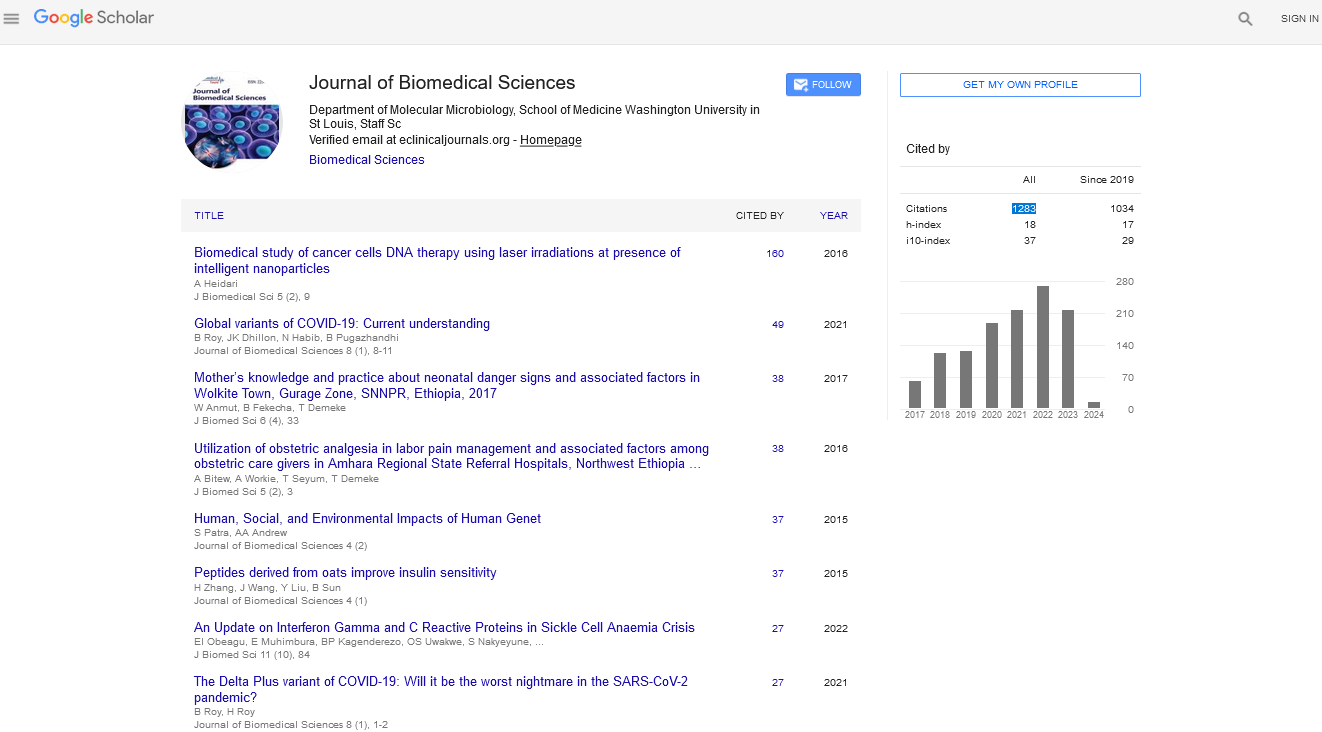Vidona WB1* and Wadioni A2
1Department of Anatomy, Gregory University, Uturu, Abia State, Nigeria
2Department of Physiology, PAMO University of Medical Sciences, Port Harcourt Rivers State, Nigeria
*Corresponding Author:
Vidona WB
Department of Anatomy, Gregory University
Uturu, Abia State, Nigeria
Tel: +2348038690470
E-mail: Wills_bills@yahoo.com
Received date: February 9, 2018; Accepted date: April 17, 2018; Published date: April 27, 2018
Citation: Vidona WB, Wadioni A (2018) Assessment of Liver Histomorphology and Curative Effect of Chloroform Extract of Telfairia Occidentalis Seed on Carbon Tetrachloride (CCL4) Induced Liver Toxicity in Wistar Rats. J Biomedical Sci. Vol.7 No.1:4. doi: 10.4172/2254-609X.100083
Copyright: © 2018 Vidona WB, et al. This is an open-access article distributed under the terms of the Creative Commons Attribution License, which permits unrestricted use, distribution, and reproduction in any medium, provided the original author and source are credited.
Keywords
Histomorphologic; Hepatocurative; Liver; Carbon tetrachloride (CCL4); Therapeutic, Hepato-toxicity; Phytochemical; fibrosis
Introduction
It has been generally known that liver is an organ that is of paramount importance because of its function in the maintenance of metabolic and detoxification of exogenous and endogenous substances such as xenobiotics, drugs, viral infections and chronic alcoholism [1] as such diverse homeostatic mechanisms would be affected with severe consequences if impaired. With reference to the total world population, it has been rated that liver problems such as hepatic disease has become common not only in Western world but also in developing countries including the Asia-Pacific area without knowing a possible cure. Aside virus being the main cause of liver disease, conventional drugs used in the treatment of liver diseases is sometimes inadequate and can cause serious adverse effects. This now made those that practice Ayurveda; the oldest systems of medicine in India which means science of life to see it as a way of life [2] and then sit checked out for more effective herbal medicines, which now lead to the high demand of herbal medications in developed as well as developing countries for primary healthcare simply because of their wide biological and medicinal activities of higher safety margins and lesser costs [3].
The significance of the study is that it gives information on the histomorphologic and hepatoprotective effect and the therapeutic use of the Telfairia occcidentlis seed in treatment of intoxicated livers, if it turns out to be hepatoprotective, several individuals that are in possession of the seed will be aware of its function and not only value it but use it in the maintenance of the functions of the liver and it will also provide a model for researchers which will guide toxicity levels in hepato-induced diseases.
The key findings of the study can be deduced that prolonged administration of carbon tetrachloride (CCL4) causes liver damage which could be remedied by continual administration of chloroform extract of Telfairia occidentalis seed at appropriate doses 8000 mg/kg/day orally. The Telfairia occidentalis seed oil is not harmful or toxic to the system even at high doses of its intake. In this study, Telfairia occidentalis seed demonstrated hepatoprotective, curative and antioxidant effect because of the presence of phytochemicals such as; Flavonoids, terpenes and alkaloids.
The Literature Review of the Study
In a research carried out by Etim on the effects of coadministration of aqueous extracts of Telfairia occidentalis and Ageratum conizoides on haematological indices, urea and creatinine in albino wistar rats, it was stated that the aqueous extract of Telfairia occidentalis increases blood parameters considerably even when compared with a standard hematinic by boosting the haematological indices during times of blood loss and anemic conditions [4].
Another research by Okoye on hepatoprotective and nephrotoxic effects of methanol leaf extract of Telfairia occidentalis in adult female albino rats (Rattus norvegicus) was done and they concluded that administration of methanol leaf extract of Telfairia occidentalis as used in their study led to significant lowering of serum activity of Alanine Phosphatase, Aspartate aminotransferase, Alanine aminotransferase and creatinine which leads to enhanced hepatocyte membrane stabilization, reduced protein and CHOL synthetic ability and possible impairment of renal function in extracted treated rat groups [5].
In a research carried out by Toma on the effect of aqueous extract of fluted pumpkin on some hematological parameters and liver enzymes in 2, 4-dinitrophenylhydrazine-induced anemic rats, it was concluded that 500mg/kg aqueous leaf extract of fluted pumpkin could elevate the packed cell volume red blood cells and hemoglobin concentration in the rats induced with 2, 4-dinitrophenylhydrazine. Hence, oral administration of the extract could cure anemia. The leaf extract also regulated the liver enzymes; Alanine aminotransferase and Aspartate aminotransferase of the rats induced with 2, 4- dinitrophenylhydrazine.
Further research on effect of methanol extract of Telfairia occidentalis seed on ovary antioxidant enzymes, serum hormone concentration and histology in wistar rats was carried out by Daramola concluded by suggesting that the methanol extract of Telfairia occidentalis seed (METOS) has antioxidant activity which is able to protect against lipid peroxidation and cell damage in ovary tissues and does not sex hormones [6-10].
Hepatotoxicity implies chemical-driven liver damage of which Carbon tetrachloride (CCL4) as an example is noticed to be closely linked in action to its metabolic activation of short-lived reactive intermediates. The reductive halogenations of carbon tetrachloride is catalyzed by cytochrome P450, which is the terminal oxidase of the hepatic mixed function oxidase system and the existence of free radicals during carbon tetrachloride metabolism has been proven by spin trapping experiments. When carbon tetrachloride is used to induce cell damage, it can either result from covalent binding of the reactive intermediates to cellular components, or from enhanced lipid peroxidation triggered by interaction of free radial intermediates with oxygen which will in turn attack unsaturated fatty acids. This whole action gives rise to destruction of lipids, particularly unsaturated phospholipids resulting in damage to intracellular membranes and the plasma membrane; inclusive.
Carbon tetrachloride (CCL4) is a colorless and noninflammable liquid chemical and an environmental pollutant known to cause tissue necrosis or cell damage. When the tissue is damaged by the chemical, it tends to leak the enzyme it produces and then takes it to the blood stream where it will be circulated generally hence affecting the whole system gradually. It causes biotransformation which then produces hepatotoxic metabolites; a highly reactive trichloromethyl free radical that is further converted to the peroxytrichloromethyl radical [11-15].
In as much as the rural area is known for its ability to develop in the treatment of individuals with herbal medications, there still stand some other plants; some of which are edible in their leafy state and others to be taken in their liquid form that cure different toxicities and have been tried, but not generally applied. Telfairia occidentalis is a perennial plant with leafy vegetable commonly known as fluted pumpkin. It stands to be of great importance in South Africa; commonly in Nigeria. It belongs to the family; curcubitaceae which consists of 90 genera and 750 species and are known to originate from tropical-West Africa. This plant is highly nutritious and contains leaves and seeds that are commonly, widely and important eaten vegetables in West Africa (Figure 1) [16-20].
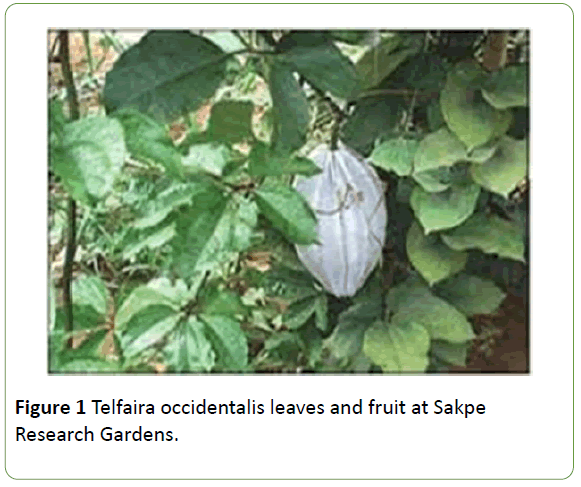
Figure 1: Telfaira occidentalis leaves and fruit at Sakpe Research Gardens.
Aims and Objectives
The aim is to evaluate the histomorphologic anatomy of the liver with CCL4 induced toxicity and hepatocurative effect of Telfaira occidentalis seed in adult wistar rats. The specific objectives include determining the effect of the Carbon tetrachloride (CCL4) on liver of rats and determining the effect of the chloroform extract of Telfairia occidentalis seed on carbon tetrachloride induced liver toxicity in rats.
Materials and Methods
Step 1
Collection and preparation of plant extracts: The plant seed was gotten in its pod from Eke Obiangwu Market in Ngor Okpala Local Government Area, Imo State. The pod of the ripened fruit was opened and the seeds inside were brought out and washed. After washing, the shell was pulled off and then the seed was dried using hot air oven of 40°C for 4 days. It was powdered after which an extract using chloroform under room temperature was made by putting the powdered seed into a bowl with chloroform, stirred and sieved.
Animal grouping: Female Wistar rats weighing between 150-180 grams were obtained from the Animal House facility of the Department of Vertinary, Michael Okpara University of Agriculture Umudike, Abia State, Nigeria and brought to Gregory university Uturu, Abia State where they were allowed for 7 days to get acclimatized to the environment. They were housed in standard cages and kept under natural day and night cycle. The animals will feed on standard laboratory animal diet and water ad libitum. And all experimental protocols were approved by the University animal ethics committee. This experiment lasted for a period of 14 days and was sacrificed on the 15th day. The organ of interest; Liver were all stored in a bottle containing formalin to avoid denature after which the histological slides of the different groups were made (Table 1).
| Grouping Pattern |
| Group |
Rat |
Days |
Administration |
| 1 (control) |
5 |
14 |
normal animal diet and water ad libitum |
| 2 (experimental) |
5 |
14 |
carbon tetrachloride (0.5 ml) + olive oil (0.5 ml) + normal diet and water ad libitum |
| 3 (experimental) |
5 |
14 |
carbon tetrachloride (0.5 ml) + olive oil (0.5 ml) + normal diet, water + 400 mg/kg of the extract |
| 4 (experimental) |
5 |
14 |
carbon tetrachloride (0.5 ml), normal diet, water + 800 mg/kg of the extract |
Table 1: The animal grouping pattern.
Step 2
Lethal dose (Ld50) determination: The lethal dose of the seed extract was gotten using Proposed (New) method which is divided into stages and the outcome in each stage determined the next step to take (whether to terminate or proceed to the next stage) (Table 2).
| Ld50 Using Proposed New Method |
| Stages |
Groups |
Rat |
Administration |
| Stage 1 |
Group 1 |
1 |
50 mg |
| Group 2 |
1 |
200 mg |
| Group 3 |
1 |
400 mg |
| Group 4 |
1 |
800 mg |
| Stage 2 |
Group 1 |
1 |
1000 mg |
| Group 2 |
1 |
1500 mg |
| Group 3 |
1 |
2000 mg |
| Stage 3 |
Group 1 |
1 |
3000 mg |
| Group 2 |
1 |
4000 mg |
| Group 3 |
1 |
5000 mg |
Table 2: Lethal Dose determination using proposed new method.
Administration of carbon tetrachloride and extract: The carbon tetrachloride and the extract was administered to the group of rats involved using 0.5 ml/kg of body weight by oral route along with 0.5 mg/kg equal volume of olive oil which will serve as its mediator for 14 days.
Preparation of the organ involved: At the end of administration and after sacrificing, the liver was isolated and fixed, after which the stages involved in tissue processing prior to microscopic evaluation were made using special techniques.
Results
Histopathological Findings
The central vein, hepatocyte and portal traid were observed to be normal in the control group (Figure 2). CCL4 is a hepatotoxic agent known to produce a characteristic centrilobular pattern of degeneration and necrosis. In the present study, CCL4 application constituted histopathological changes in the liver (Figure 3); severe hyperemia was observed in the area surrounding the central veins which led to wide vacuolar degeneration of hepatocytes and lymphocyte. There was rearrangement of the hepatocyte cord and necrosis at the periphery of central vein were also determined (Figure 2). In group 3 (Figure 4) it was noticed that minimal tissue degeneration was observed at the periphery of the central vein because of Telfairia occidentalis seed in as much as CCL4 was given to the group as well. In group 4 (Figure 5) there was no rearrangement of the hepatocyte cords, though the focal aggregate inflammation was still observed, the administration of Telfairia occidentalis seed was able to resist the congestion of the central vein [21-24].
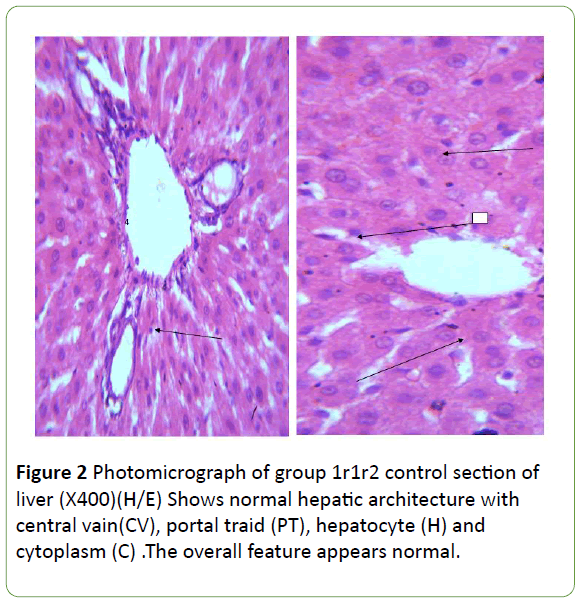
Figure 2: Photomicrograph of group 1r1r2 control section of liver (X400)(H/E) Shows normal hepatic architecture with central vain(CV), portal traid (PT), hepatocyte (H) and cytoplasm (C) .The overall feature appears normal.
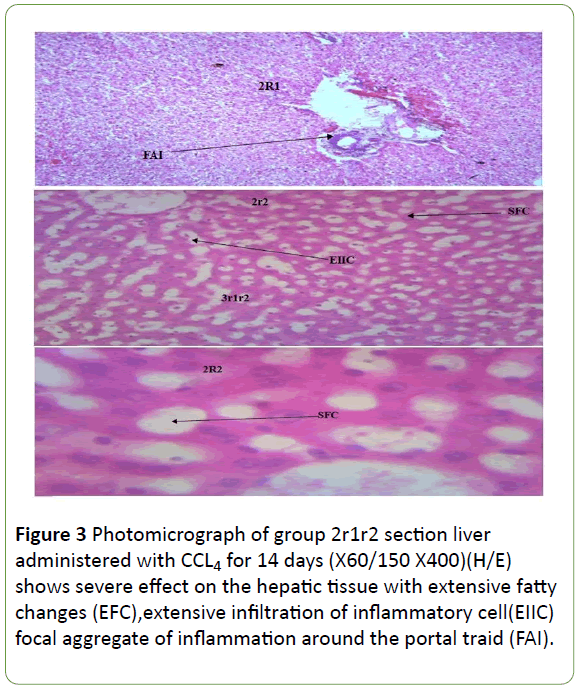
Figure 3: Photomicrograph of group 2r1r2 section liver administered with CCL4 for 14 days (X60/150 X400)(H/E) shows severe effect on the hepatic tissue with extensive fatty changes (EFC),extensive infiltration of inflammatory cell(EIIC) focal aggregate of inflammation around the portal traid (FAI).
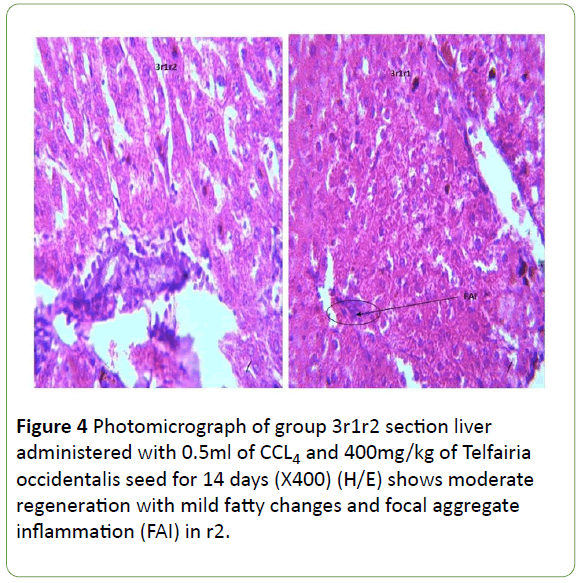
Figure 4: Photomicrograph of group 3r1r2 section liver administered with 0.5ml of CCL4 and 400mg/kg of Telfairia occidentalis seed for 14 days (X400) (H/E) shows moderate regeneration with mild fatty changes and focal aggregate inflammation (FAI) in r2.
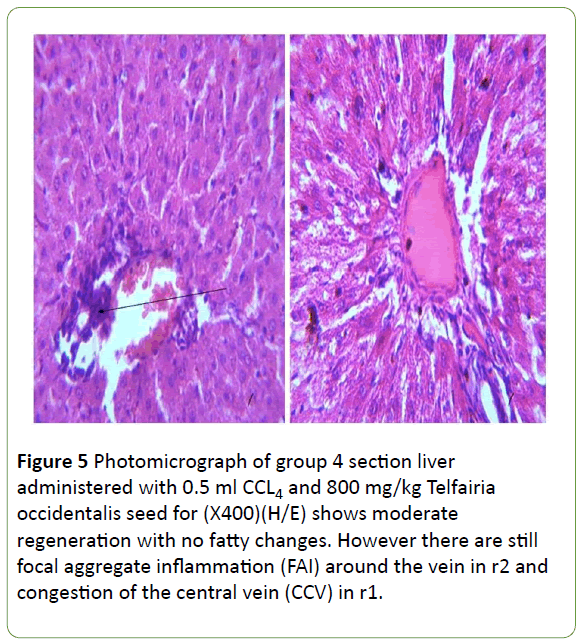
Figure 5: Photomicrograph of group 4 section liver administered with 0.5 ml CCL4 and 800 mg/kg Telfairia occidentalis seed for (X400)(H/E) shows moderate regeneration with no fatty changes. However there are still focal aggregate inflammation (FAI) around the vein in r2 and congestion of the central vein (CCV) in r1.
Discussion
The results of this study agree with previous researchers that Telfairia occidentalis seed has hepato-protective effect on male wistar rats. With the use of CCL4 induced toxicity, the liver showed infiltration by inflammatory cells and congestion of central vein. The pattern of tissue disruption observed in this study are similar to those described by other researchers on effects of these substances on the histology of the liver.
It was observed that during the studies that the group in which the rats were treated with higher dosage of Telfairia occidentalis feeds showed improved liver architecture.
With reference to Figure 2, it would be noticed that; the group 1 maintained their normal hepatic architecture with central vein (CV), Portal Traid (PT), Hepatocyte (H), and Cytoplasm (C). This is in agreement with the work carried out by Sadeghi on Hepatoprotective effect of Cichorium intybus on CCL4-induced liver damage in rats where the liver of the animals in group 1 showed normal hepatic architecture with distinct hepatic cells, sinusoidal spaces and a central vein.
In Figure 3, this represents the rats in group 2 which showed severe effects on the hepatic tissue with extensive fatty changes, extensive infiltration of inflammatory cell (EIIC) and Focal Aggregate of Inflammation (FAI) around the portal vein. Mortality occurred in this group after the first 7 days of administration, because CCL4 is to some extent governed by the partial pressure of oxygen in tissues. The low partial pressure then results in predominant formation of CCl3 and CHCl radicals and covalent metabolite binding, hence, affecting the metabolism of lipids and results in fatty liver. This reaction is in agreement with the work of Meinrad in the result of metabolic activation of CCL4 that it causes accumulation of fat and damage of the liver because of the presence of intact cytochrome P450 oxygenase system [25-26].
In Figure 4, this represents the rats in group 3 which showed moderate generations with wild fatty changes and Focal Aggregate of Inflammation (FAI) in r2. The moderate nature of Alkaloids, terpenes, including the Plant phenols and Flavonoids in the Telfairia occidentalis seed showed their striking feature in this group. This is in agreement with numerous studies that suggested that flavonoids commonly function as antioxidants and may protect different organs against oxidative stress caused by suboptimal environmental conditions.
In Figure 5, this represents the rats in group 4 which showed moderate regeneration with no fatty changes. However there is still Focal Aggregate Inflammation (FAI) around the vein in r2 and congestion of central vein in r1. This is because of the presence of the phytochemical constituents such as; Alkaloids, Terpenes, Flavonoids, phenolic compounds, volatile oils and Tannins. The tannin which is low still strived in its activity of bringing the liver back to a proper function. The higher dosage taken by this group really showed an improved feature of the intoxicated liver. This is in agreement with what happened in Figure 4 because of the presence of phytochemical constituents contained in the chloroform extract of Telfairia occidentalis seed.
These features shown by the liver in different groups reveals that chloroform extract Telfairia occidentalis seed is not only hepatoprotective, but also curative and preventive because the groups that received the administration had their liver brought back close to normal and also possess comparative histological features just as the control group.
To buttress the curative and preventive activities of chloroform extract of Telfairia occidentlais seed, a research done by Ademola in Post-treatment with Telfairia occidentalis seed oil attenuates alcohol-induced testicular damage in Sprague- Dawley rats showed that Ethanol administration resulted in deleterious histological testicular changes, low plasma testosterone with concomitant low luteinizing Hormone levels.
Conclusion
It could be deduced that prolonged administration of carbon tetrachloride (CCL4) causes liver damage which could be remedied by continual administration of chloroform extract of Telfairia occidentalis seed at appropriate doses 8000 mg/kg/day orally. The Telfairia occidentalis seed oil is not harmful or toxic to the system even at high doses of its intake. Amelioration with this extract appeared effective at the given dosages. In this study, Telfairia occidentalis seed demonstrated hepatoprotective and curative effect on hepato-induced damages. However further experimental studies on Telfairia occidentaliss regarding its antioxidant effect and subchronic levels not only the liver but other organs of the body should be carried out.
22589
References
- Abiose S (1999) Assessment of the extent of use of indigenous African food; introduced foods and imported foods in hotels and other commercial eating places in south western Nigeria. African natural resources conservation and management surveys (J. J. Baidu-forson, ed) UNN/INRA Accra.
- Ademola AO, Edidiong MA, Ctherine CA, Iniebehe EO, Onyemaechi OA (2013) Post-treatment with telfairia occidentalis seed oil attenuates alcohol-induced testicular damage in Sprague-Dawley rats. Iranian Journal of Reproductive Medicine.11: 637-646.
- Bohnert HJ, Jensen RG (1996) Strategies for engineering water stress tolerance in plants. Trends Biotechnol 14: 89-97.
- Boll M, Weber LWD, Becker E, Stampfl A (2001) Pathogenesis of carbon tetrachloride induced hepatocyte injury. Bioacttivation of CCl4 by cytochrome P450 and effects of lipid Homoeostasi. Z. Naturforsh. 56: 111-121.
- Chattopadhyay RR, Bhattachargya SK (2007) Terminalia Chebula, Pharmacology 1: 439-445.
- Cheeseman KH, Albano EF, Tomasi A, Slater TF (1985) Biochemical studies on the metabolic activation of halogenated alkanes. Environmental Health Perspective. 64: 85-101.
- Conner HD, Thurman RG, Galizi MD, Mason RP (1986) The formation of a novel free radical metabolite from CCl4 in the perfused rat liver and in vivo. Journal of Biological Chemistry 261: 4542-4548.
- Dienstang, JL, Tsselbacher KJ (2001) Toxic and drug-induced hepatitis, 15th Edition. The McGraw-Hill companies. Harrison's principles of internal medicine 2: 1737-1742.
- Daramola OO, Oyeyemi WA, Odiase LO, Olorunfemi AA (2016) Effects of methanol extract of Telfairia occidentalis seed on ovary antioxidant enzymes, serumhormone concentration and histology in wister rats. International Journal of Pharmacognosy and phytochemical research 8: 1245-1249.
- Etim OE, Akpan HD, Usuah JA (2015) Effects of co-administration of aqueous extracts of Telfairia occidentalis and ageratum conizoides on haematological indices, urea and creatinine in albino wistar rats. European journal of biology and medical science research. 3: 1-10.
- Esiaba RO (1982) Cultivating the fluted pumpkin in Nigeria. World Crops 34: 70-72.
- Gould KS, Lister C (2006) Flavonoid functions in plants. In: Andersen OM, Markham KR (eds): Flavonoids: Chemistry, Biochemistry and applications. London: CRC presss 397-440.
- Irvine FR (1969) West Africa crops. 3rd Edition Oxford university press London 67-78.
- Jaeger RJ, Conolly RB, Murphy SD (1975) Short term inhalation toxicity of halogenated hydrocarbon. Architecture of Environtal Health 30: 26- 31.
- Magos L, Showden R, White INH, Butter WH, Tuffery AA (1982). Isotoxic oral and inhalation exposure of carbon tetrachloride in portion- wistar and fisher rats. Journal of Applied Toxicology 2: 238-240.
- Meinrad B, Lutz WDW, Eberhard B, Andreas S (2001) Institute of toxicology, National research centre for environment and health. Z. Naturforsh 56: 649-659.
- Nogushi T, Fong KL, Lai EK, Alexander SS, King MM, et al. (1982) Specificity of a phenobarbital-induced cytochrome P450 for metabolism of carbontetrachloride to trichloromethyl radical. Biochemical Pharmacology 31: 615-624.
- Okoye CN, Ihedioha JK, Agina OA, Ochiogu I, Ogwu, D (2016) Hepatoprotective and nephrotoxic effects of methanol leaf extract of Telfairia occidentalis (Hook F.) in adult female albino rats (Rattus norneginus). The journal of pathological science. 40: 167-171.
- Rice-Evans CA, Miller NJ, Papanga G (1997) Antioxidant properties of phenolic Compounds. Trends plant sci 2: 152-159.
- Sadeghi H, Nikbakht MR, Ghaitasi I, Sabzali S (2008) Hepatoprotective effect of Cichorium intybus on CCl4-induced liver damage in rats. African Journa of biochemical Research 141-144.
- Siegers CP, Horn W, Younes M (1985) Effect of hypoxia on the metabolism and hepatotoxicity of carbon tetrachloride and vinylidene chloride in rats. Actapharmacology Toxicology. 56: 81-86.
- Tattini M, Galardi C, Pinelli P, Massai R, Remorini D, et al. (2004) Differential accumulation of flavonoids and hydroxycinnamates inleaves of Ligustrum vulgare under excess light and drought stress. New Phytol 163: 547-561.
- Toma I, Victory NC, Kabir Y (2015) The effect of aqueois leaf extract of fluted pumpkin on some hematological parameters and liver enzymes in 2, 4-dinitrophenylhydrazine induced anemic rats. African Journal of Biochemistry research 9: 95-98.
- Williams T, Burk RF (1990) Carbon tetrachloride hepatotoxictiy: an example of free radical-mediated injury, seminar On Liver Disorders 10: 279- 284.





